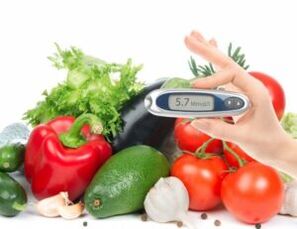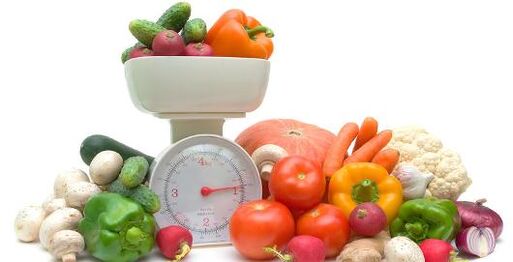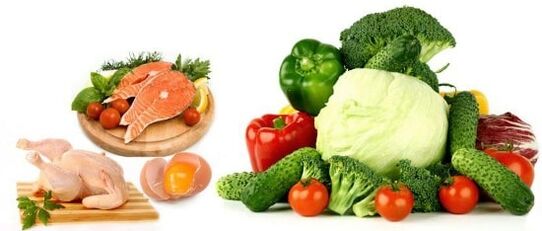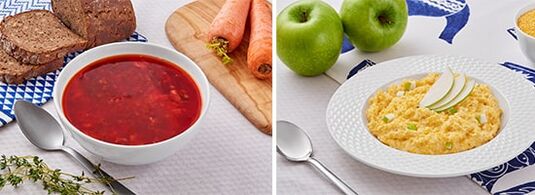
Diabetes mellitus is a chronic endocrine disease in which the metabolism is disturbed due to lack or improper functioning of the hormone insulin.
Insulin-dependent (type 1) and non-insulin-dependent (type 2) diabetes are distinguished.
In the first case, the patient should take insulin preparations in the form of injections, since the hormone in their body is produced in insufficient or completely absent quantities.
In the second type, insulin's interaction with cells is disrupted.
Despite the different mechanisms of the development of the pathology, the main role in its therapy is assigned to the nutritional diet.
Features of the diet for diabetics
In the past, the food suppression system was the only way to limit hyperglycemia, or high blood sugar. Now the patient's diet has expanded significantly. Diabetics should follow some important rules for effective blood sugar control.
The patient should not be hungry or overeat. These conditions are dangerous to their health. You need to eat so that the amount of carbohydrate consumed is evenly distributed throughout the day.
General dietary requirements:
- fractional nutrition (at least 6 times a day);
- calculate the amount of carbohydrates consumed;
- limit animal fat;
- inclusion of plant foods in the diet;
- preferred food steamed, in the oven, boiled;
- avoiding foods that increase carbohydrate intake, or limiting them;
- balancing diet;
- replace sugar with substitutes;
- consumption of foods with crude fiber;
- compliance with the drinking regime;
- reduce salt intake;
- alcohol reduction.
You can diversify your diet by purchasing utensils that allow you to cook food without oil.
In order for carbohydrates to be absorbed more slowly and not to increase blood sugar, you need to adhere to the following recommendations:
- Eat raw or grainy foods, such as whole grains, instead of mashed or boiled.
- Meals should not be hot because temperature affects glucose absorption.
- Dietary fiber inhibits the absorption of simple carbohydrates and helps remove cholesterol.
- Simple carbohydrates are best consumed after a main meal.
The menu may include foods that contain simple carbohydrates with fiber, such as fruits and berries. Glucose absorption is slowed if consumed with protein (protein cream) or fat. However, don't forget that "slow" carbohydrates are also absorbed into the bloodstream, increasing sugar levels.

Nutritional differences in type 1 and type 2 diabetes
Since the reasons for the elevation of blood sugar in the first and second types of disease are different, there are several approaches to the patient's diet. For insulin-dependent patients, the diet is more varied. Since they suffer from this pathology more often in their youth, high-calorie foods are introduced into the diet. When making a diet, the units of cereals consumed are taken into account.
In type 2 diabetes, the main task of nutrition is to lose weight. In this case, the menu is calculated according to the calorie content of the product. The patient's diet is more rigid. They are not allowed to give sugar, fatty foods and foods that raise cholesterol.
Bread unit

The term "bread unit" (XE) was introduced to explain the quantitative composition of carbohydrates. For 1 XE, it is considered 25 g of bread or 12 g of sugar (carbohydrate). The bread unit diagram is necessary for diabetics to calculate the amount of short insulin to be used.
1 VEHICLE need 2-4 pcs. insulin. An individual's need for additional insulin under XE is determined using a self-administered diary, which is to be kept by the patient.
In a single meal, diabetics should not eat more than 7 XE. The main carbohydrate intake occurs in the first half of the day.
In order not to have to constantly calculate the bread units by the weight of the product, we have created the product table taking into account their energy value.
What is the glycemic index of food?
The glycemic index (GI) is an indicator of how much blood sugar may rise with the use of a particular product relative to the use of glucose.
High GI foods (70 or more):
- Beloved husband,
- glucose sugar;
- Street;
- mashed potato;
- sweet soda;
- candy - corn stick, puffed rice.
Average GI (56-69):
- melon;
- banana;
- oatmeal;
- black bread.
The lowest GI has:
- dairy products;
- Milk;
- fruits;
- peas, beans, lentils and other legumes.
Absorption rate is affected by cooking process, food integrity and temperature.
In diabetes, only foods with medium and low GI are allowed.
List of allowed and prohibited products
The principles of the diet for diabetics with different types of diseases are different. However, there are foods that endocrinologists do not recommend.
The list of prohibited foods includes:
- french fries, french fries, french fries;
- sweet fruit - grapes;
- meat;
- Bacon;
- canned food in oil;
- pate;
- sweetened curd, curd;
- sweet yogurt;
- Margarine;
- white bread and white flour pastries;
- juice from the store;
- Soft drink;
- alcohol;
- chocolate;
- jam;
- condensed milk;
- fast food.
Patients will have to love the following foods and drinks:
- mineral water;
- rosehip;
- vegetable juices;
- fresh juices from sweet and sour fruits and vegetables;
- unsweetened citrus fruits;
- frozen and fresh strawberries;
- low-fat dairy products without sugar;
- diet meat - chicken, turkey, veal, rabbit;
- cabbage;
- pea's tree;
- mushroom;
- tomato;
- eggplant;
- green vegetables;
- asparagus;
- broccoli;
- Milk;
- whole-wheat pies;
- seafood;
- fish.
To reduce the starch content of vegetables and grains, it is advisable to soak them before cooking.
Rules for compiling menus
When composing a menu, it is important to consider not only the carbohydrate and calorie content of the food, but also the activity of the diabetic patient. Exercise lowers blood sugar. For type 1 diabetes, it is recommended to eat 1 XE for every hour of physical activity. This will prevent you from changing your bolus insulin dose.
With obesity, a dietitian will help prepare a diet that takes into account the energy content (calories) of foods and the daily energy expended during physical activity. The calculation takes into account the gender, age and obesity level of the patient. It is allowed to arrange fasting days (with type 2 diabetes). However, fasting is contraindicated in such patients.
During the preparation of the menu, the general condition of the diabetic patient is taken into account. Pregnant and lactating women, adolescents, and debilitated patients need protein supplements. If the patient has liver and kidney failure, ketoacidosis, reduce protein intake.
Do not forget about other nutrients involved in metabolism: vitamins, zinc, copper, manganese. Because patients tend to have diseases of the cardiovascular system, the salt content in dishes is reduced.
Sample menu for a week
Monday
- Breakfast: buckwheat porridge, bran bread with butter, tea;
- snack: cabbage salad with eggs;
- lunch: chicken soup, vegetable salad with herbs, green beans with white meat cutlets, french fries, diabetic rye bread;
- afternoon snack: bread with yogurt;
- dinner: steamed zrazy with fish, rye bread, vegetable salad;
- Snack: drink fermented milk.
Tuesday
- breakfast: oatmeal, cereal bread with butter, tea;
- snack: parsley, onion and mushroom salad;
- lunch: bean soup, grilled chicken with vegetables, vegetable salad, cereal bread, drink;
- afternoon snack: fermented baked milk with biscuits;
- dinner: fish stew with vegetables, cereal bread, juice;
- Snack: yogurt.
Wednesday
- breakfast: porridge "Artek", bran bread with butter, coffee;
- snack: celery, apple and carrot salad;
- lunch: borscht, buckwheat porridge with steamed cutlets, sauerkraut salad, bran bread, compote;
- afternoon snack: cheese with fruit;
- dinner: bigos with sauerkraut and meat, bran bread, juice;
- Snack: baked apple.
Thursday
- breakfast: eggs, rye bread with butter, tea;
- snack: cheese with yogurt;
- lunch: green borscht, grilled eggplant with meat, tomato salad with low-fat sour cream, rye bread, compote;
- afternoon snack: curd pudding with tea;
- dinner: casserole with vegetables, rye bread, drink;
- Snack: bread with kefir.

Friday
- Breakfast: pearl barley porridge, nut butter bread, tea (chicory, coffee);
- snack: fruit salad with yogurt;
- lunch: fish soup, fish cutlet with garnish, bell pepper and cucumber salad, cereal bread, citrus drink;
- afternoon snack: bread with milk;
- dinner: steamed cutlet with milk sauce, porridge, cereal bread, lemonade;
- Snack: fruit.
Saturday
- breakfast: omelette with veal, bran bread with cheese, tea;
- snack: cheese with berries;
- lunch: mushroom soup, boiled (grilled) meat porridge, canned beans with onions and herbs, bran bread, compote;
- afternoon snack: oat biscuits with fermented baked milk;
- dinner: stuffed zucchini, porridge, bran bread, drinks;
- snack: fermented baked milk.
Sunday
- Breakfast: brown rice with minced meat and cabbage (cabbage roll), rye bread with butter, tea;
- snack: bread with yogurt;
- lunch: soup with meatballs, omelet with chicken, red cabbage salad, rye bread, drink;
- afternoon snack: kefir with biscuits;
- dinner: fish cakes, baked potatoes, rye bread, drinks;
- Snack: biscuits with milk.
The trial menu is compiled by a nutritionist. In the future, diabetics supplement their own diet, taking into account the recommendations of the doctor.
Ready meals for diabetics
To eat properly to cure diabetes, you need to put in a lot of time and effort. Most diabetics simply don't have enough time to plan menus and prepare food properly, so now I would like to introduce you to Cryodieta company, the company that helps people's lives. diabetes easier.
Cryodieta is a ready-to-eat and delicious food delivery service not only for diabetics but also for people who want to lose weight. The menu is prepared by experts - qualified nutritionists and doctors.
Thanks to the special "freeze" technology, you just need to warm up the food in the microwave or multi-cooker and have a delicious meal. At the same time, freezing still retains all nutrients.
The main advantages of "Cryodiet":
- production of products in the ecologically clean zone of the Novgorod region;
- delivery without delay in person;
- many kinds of food;
- shock freezing (keeping food without preservatives);
- More affordable prices than competitors.
Examples of dishes

The diabetes ready-to-eat food delivery service operates in major cities, so if you want to eat healthy food and it doesn't take long, order the weekly menu on the official website.
Sugar substitutes
In order for the patient not to be short of sweets, sweeteners can be added to the dishes. They are divided into three groups:
- Carbohydrates - fructose, sorbose, xylitol, sorbitol, molasses.
- Protein sweeteners - magiculin, monelin.
- Synthetic - aspartame, sodium cyclamate.
Endocrinologists recommend using stevia as a natural sweetener. Its leaves contain a glycoside complex, which is 200 times sweeter than sugar. Sweeteners are beneficial for people with obesity, high cholesterol and high blood sugar. Due to its ability to normalize metabolism, stevia helps to restore the anti-toxic function of the liver.
Plant glycosides stimulate immunity, reduce sugar levels, have a beneficial effect on the digestive and endocrine systems. Drinks with stevia extract help overcome cravings for high-sugar and fatty foods, and help you lose weight.
High blood sugar is not a death sentence for patients if you learn to follow the diet and use healthy sweets instead of sugar. Also, do not forget about the obligatory consultation with an endocrinologist.
































































